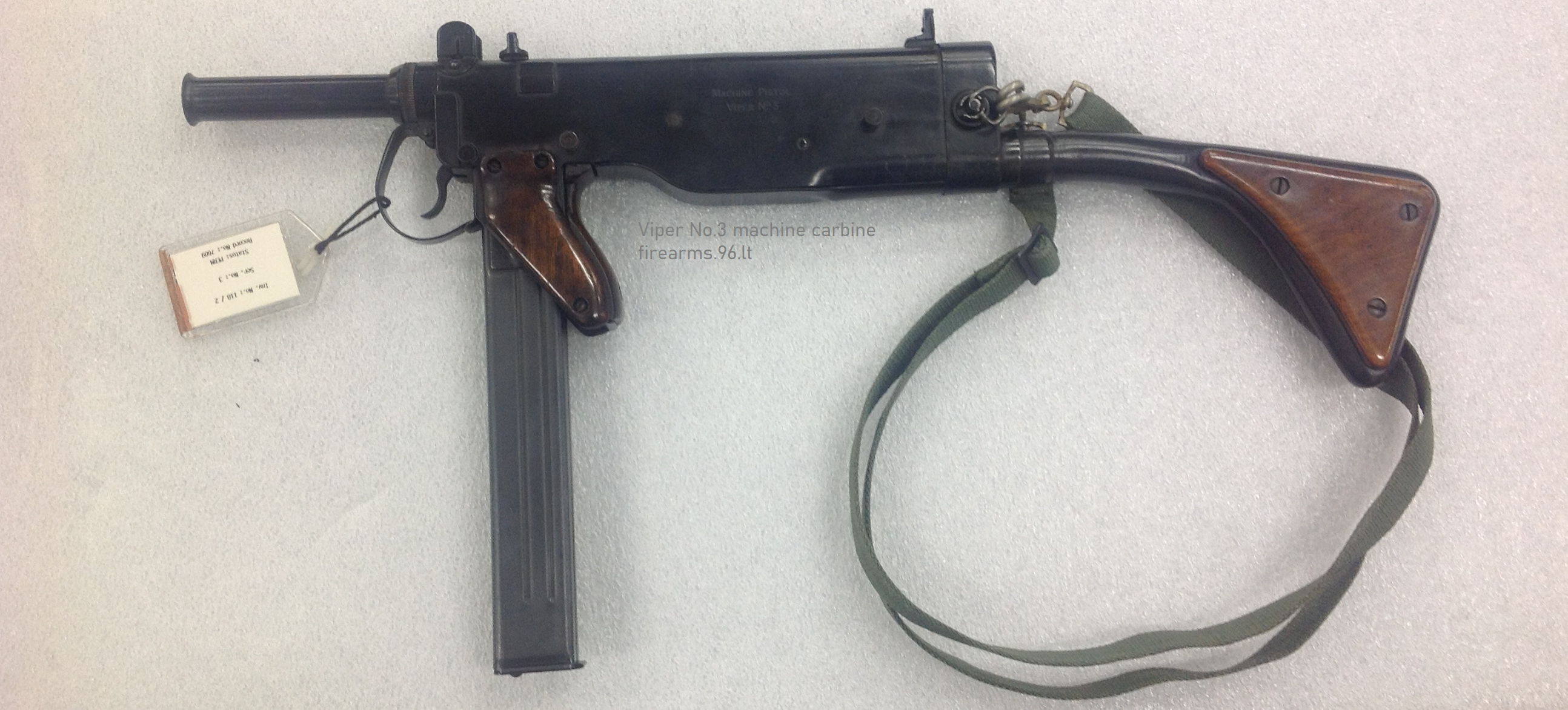The "Viper" submachine gun was the
brainchild of Derek Alfred Hutton-Williams, the director-general of the
Royal Ordnance Factories during World War II (including RSAF Enfield,
where the gun was developed). Hutton-Williams conceived the first
iteration of the Viper in 1942, and after being granted a small budget by
the Ordnance Board to develop the weapon, he built two rudimentary
prototypes. This iteration, known as the Mk.I, was a highly unusual weapon
built from a Sten Mk.III receiver encased in a large, oddly-shaped wooden
stock which opened in two halves like a clamshell (a disassembly technique
also utilized by the later Madsen Model 50). The trigger was placed
adjacent with the magazine rather than behind it - not quite sure whether
this qualifies it as a bullpup or not! There were no sights and indeed the
weapon was not intended to be shouldered at all. Rather, the curve in the
buttstock was designed to fit comfortably under the user's armpit, to
allow them to fire the weapon one-handed from the hip.
So who actually required such a weapon? Well, this is where consensus
seems to differ a little. Jonathan Ferguson (keeper of arms at the Royal
Armouries Collection), in his own research on the weapon, came to the
conclusion that it was intended as an assault weapon for commandos, so
that they could charge an enemy position while hip-firing the Viper in one
hand and lobbing grenades with the other. However, Thomas Nelson (author
of the excellent
The World's Submachine
Guns) wrote that it was intended for a wide variety of purposes,
including artillerymen, grenadiers, line of communications, tankers,
paratroopers, and - most interestingly - military police motorcyclists.
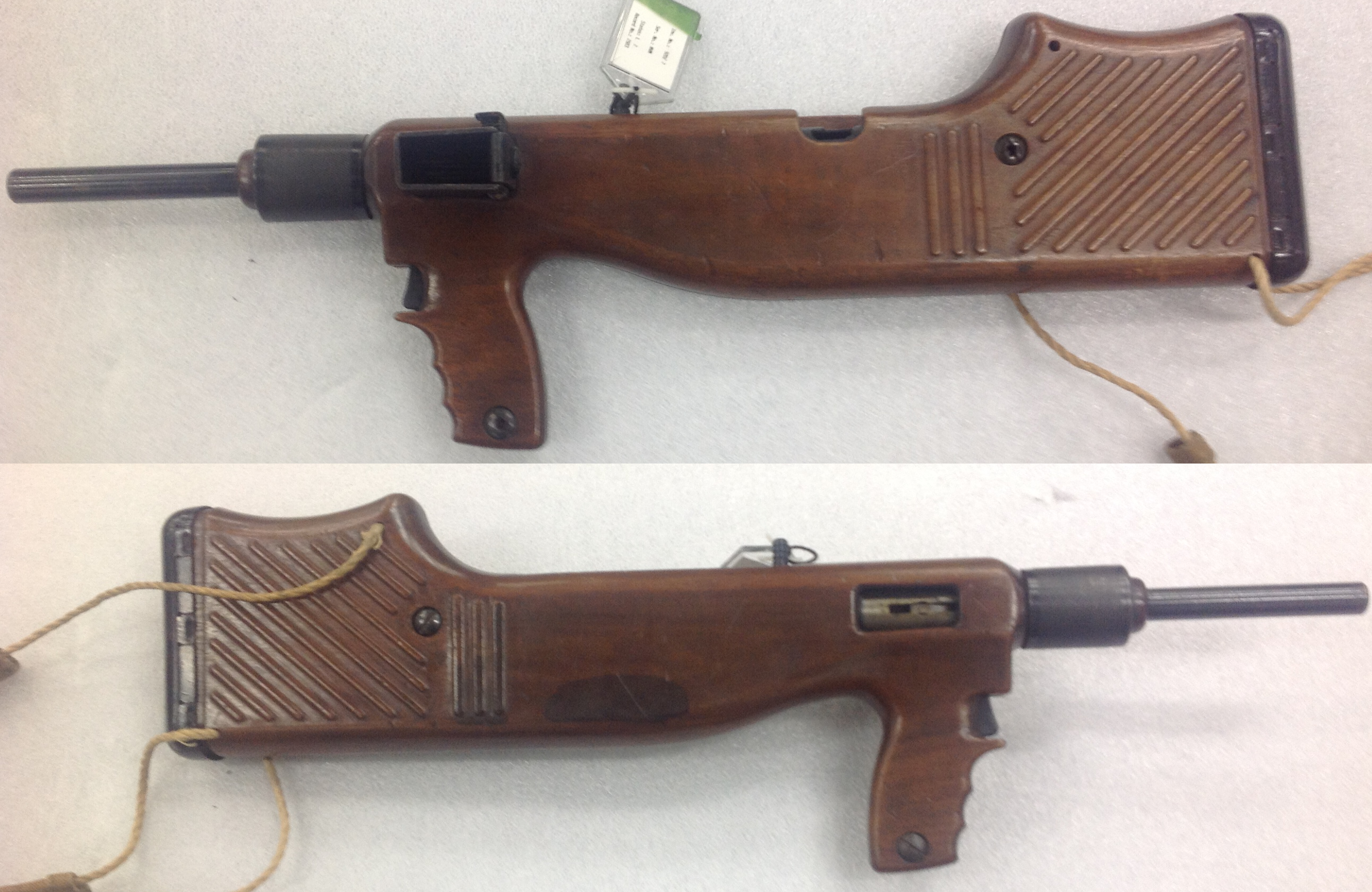
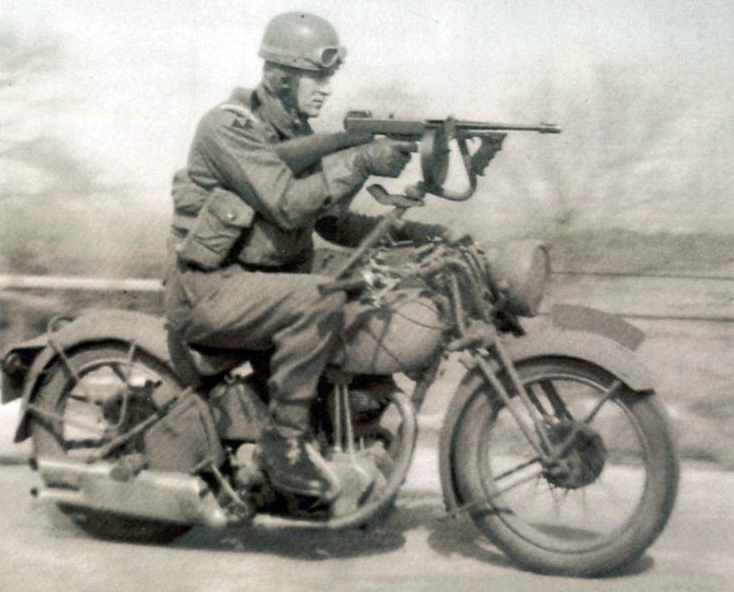 Left
Left - the Mk.I Viper machine
carbine, a Sten in a wooden clamshell stock.
Right
- a typical British MP motorcyclist with mounted Thompson gun.
(Photo: firearms.96.lt via the Royal
Armouries Collection)
British military policemen were typically equipped with a Thompson gun
mounted on a fixed pintle to their motorcycles. The Viper offered a
lighter and more practical alternative by allowing the driver to let the
gun hang freely under one shoulder by way of the butt-mounted sling, and
then when the situation called for it, they could easily reach with one
hand for the pistol grip and bring the Viper up to their hip, with the
stock resting under their armpit. The driver's free hand could still keep
hold of one of the motorcycle's handlebars, although obviously it is
assumed that they would not be attempting to fire whilst driving at speed.
The Mk.I Viper was made in two prototypes, a wooden model (as pictured)
and a Bakelite model. Tests were made of both models but they were never
placed into service for reasons that should be somewhat obvious.
Hutton-Williams was given further funding to develop the project, however,
which resulted in the conception of the Mk.II and Mk.III models. The Mk.II
existed on paper only and was similar in shape to the Mk.I, but relocated
the magazine feed to the pistol grip and featured some eccentric qualities
like a retracting stock containing an oiler and a magazine loader, and a
clip-on mount for a spare magazine to lay horizontally underneath the
length of the receiver. The Mk.III (or No.3) did not appear until the end
of the war and was designed to meet the 1945 General Staff specifications
for SMGs. The concept for the weapon still remained the same however, with
it being intended for issue to military policemen in occupied West
Germany.
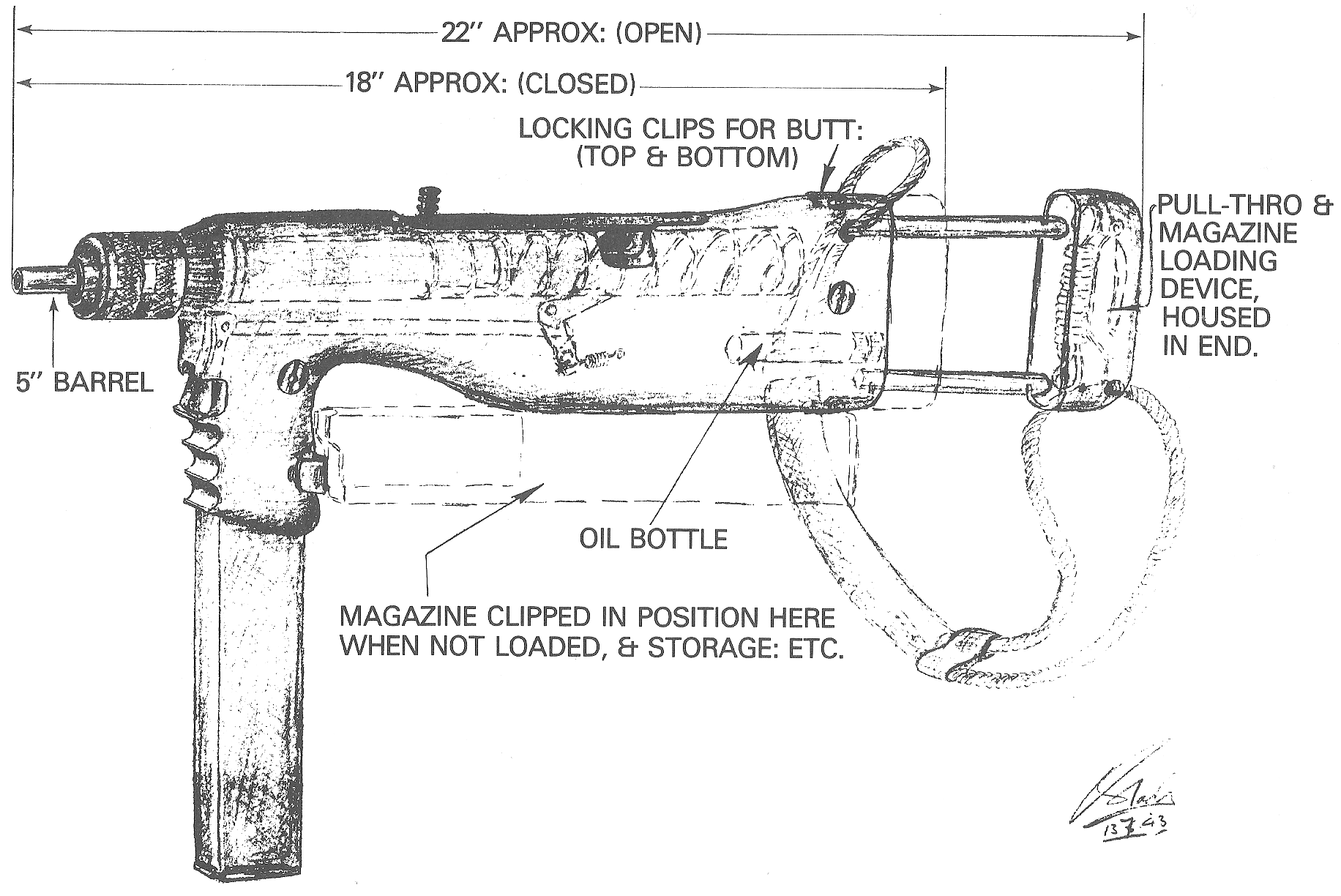
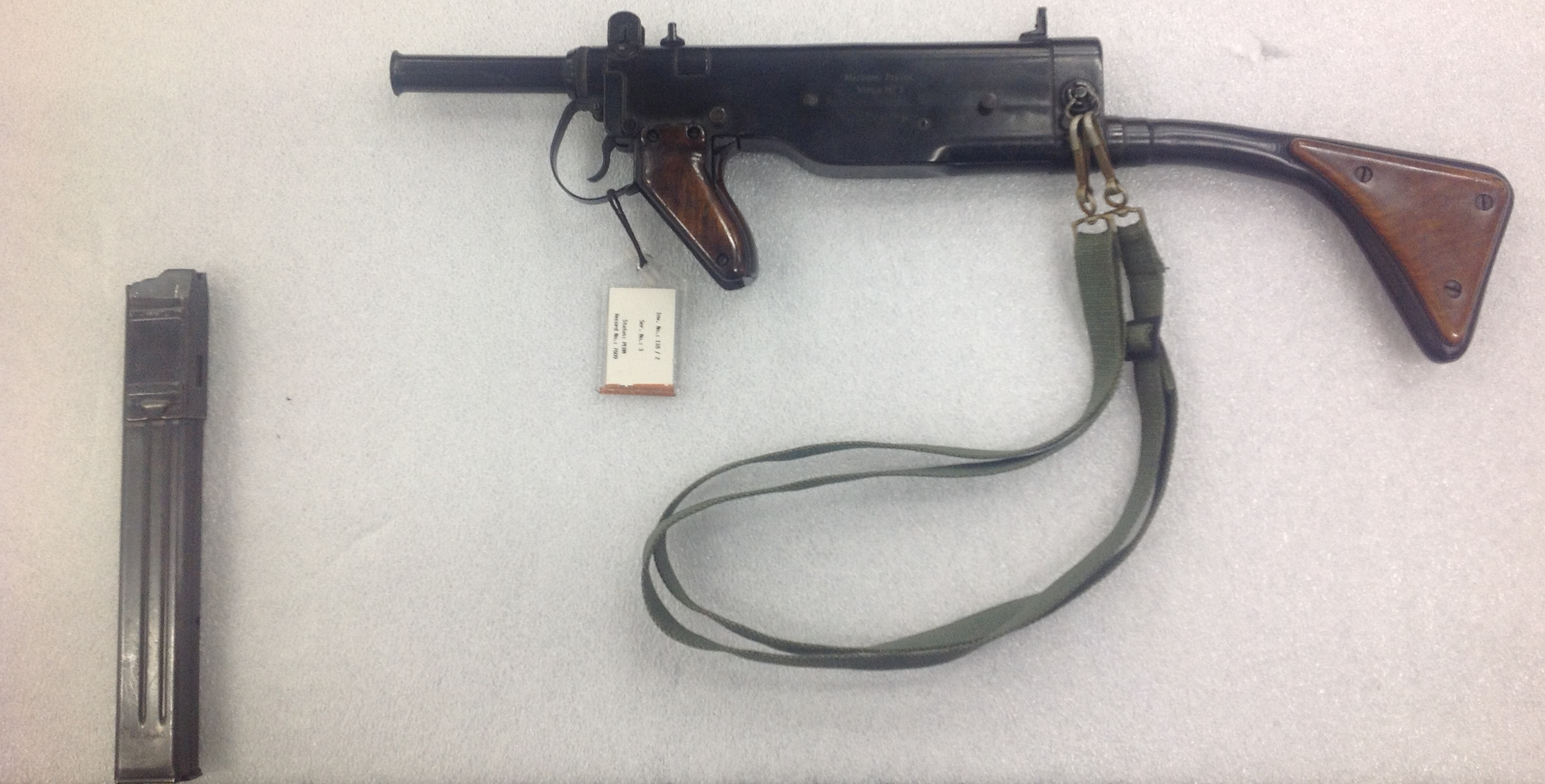 Left
Left - design sketch of the
conceptual Mk.II Viper, never produced in physical form.
Right
- the Mk.III/No.3 Viper, with 4.7in barrel and MP40 magazine.
(Photo: firearms.96.lt via the Royal
Armouries Collection)
The No.3 Viper was built on an entirely new receiver with new components.
It was still designed to be fired one-handed and thus the trigger group
and pistol grip (through which the magazine was fed) were very far
forward. Three interchangeable barrels were offered, in lengths of 4.7in,
6in, and 7.5in. The fire selector was an unusual type, being a push-in
button rather than a lever. Pushing it in half-way gave single shots and
pushing it fully gave automatic fire. In addition to this, the trigger was
push-sensitive, so even if the fire selector button was pushed in fully,
single shots could still be achieved by a light press of the trigger. The
bolt was fitted with a rubber buffer and a dead weight which moderated the
fire rate to just under 700rpm. The No.3 Viper fed from German MP38/MP40
magazines, apparently to take advantage of the large amount of surplus
magazines available in West Germany.
After brief tests in 1945, the Ordnance Board rejected the No.3 Viper on
the basis that the fire rate was too high and the weapon was underweight -
it was common for SMGs to be rejected for being too heavy, but rare for
them to be considered too light. The weight specification set out by the
General Staff requested a weight of no more than 6lb, whereas the Viper
weighed only 4.75lb - surely this was a successful attribute??? But the
Ordnance Board disagreed and thought the full 6lb weight should be taken
advantage of. Damned if you do, damned if you don't!
Derek Hutton-Williams never designed another SMG as far as I know, but he
continued working at RSAF Enfield and became superintendent of the factory
in 1964. He retired in 1975 and died in 2001 at the age of 87.
Back to database
